NP2 Long Tracts of the CNS1
1/52
There's no tags or description
Looks like no tags are added yet.
Name | Mastery | Learn | Test | Matching | Spaced |
|---|
No study sessions yet.
53 Terms
How many pairs of spinal nerves are there in the body?
31 (62 nerves)
Sensory inputs: Dermatome
Area of skin innervated by a single dorsal root
How many dermatomes?
62 dermatomes (62 nerves = 62 dermatomes)
Each nerve covers:
Only particular area of skin, not the entire skin.
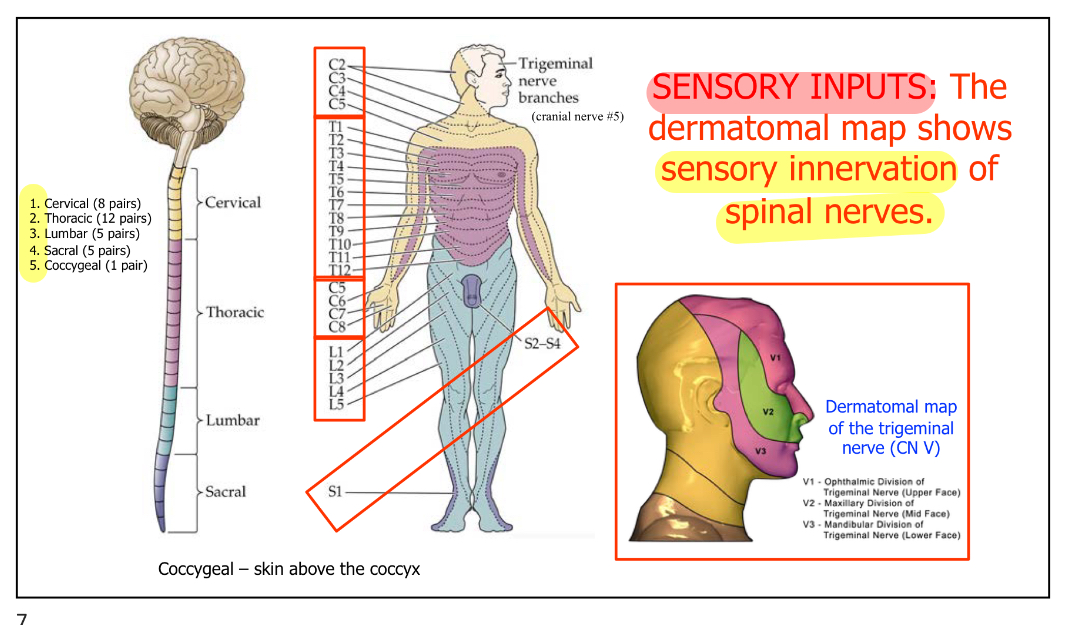
1 motor neuron innervates:
Multiple skeletal muscle cells
Many, many neurons innervate:
The entire muscle
α-motor neurons innervate:
Muscle cells
Motor neuron pool
All neurons innervating 1 single muscle
Gastrocnemius muscle is innervated by:
7 spinal nerves (7 segments; L4-S3)
Soleus muscle is innervated by:
5 nerves (5 segments; L4-S1)
In sensory system, there are how many neurons?
3
In sensory system, what are the neurons called?
Primary neuron
Secondary neuron
Tertiary neuron
In motor system, how many neurons?
2
In motor system, what are the neurons called?
Corticospinal (upper motor) neuron
α-motor (lower motor) neuron
What are the 3 long tracts called?
Dorsal column-medial lemniscal tract => sensory
Spinothalamic tract (aka. anterolateral system) => sensory
Corticospinal tract (aka. pyramidal tract) => motor
Dorsal column-medial lemniscal tract
Begin in skin (sensory information: Touch).
Cell body of 1st order neuron (primary) is located in dorsal root ganglion (DRG) outside CNS.
Axons ascend to caudal medulla. This is ipsilateral (on same side of body).
2nd order neuron (secondary): caudal medulla. Axons cross midline and continues to thalamus.
3rd order neuron (tertiary): Ventral posterior lateral (VPL) nucleus of thalamus. Sends its projections to somatosensory cortex.
Cortex has sensory representation of all sensory systems.
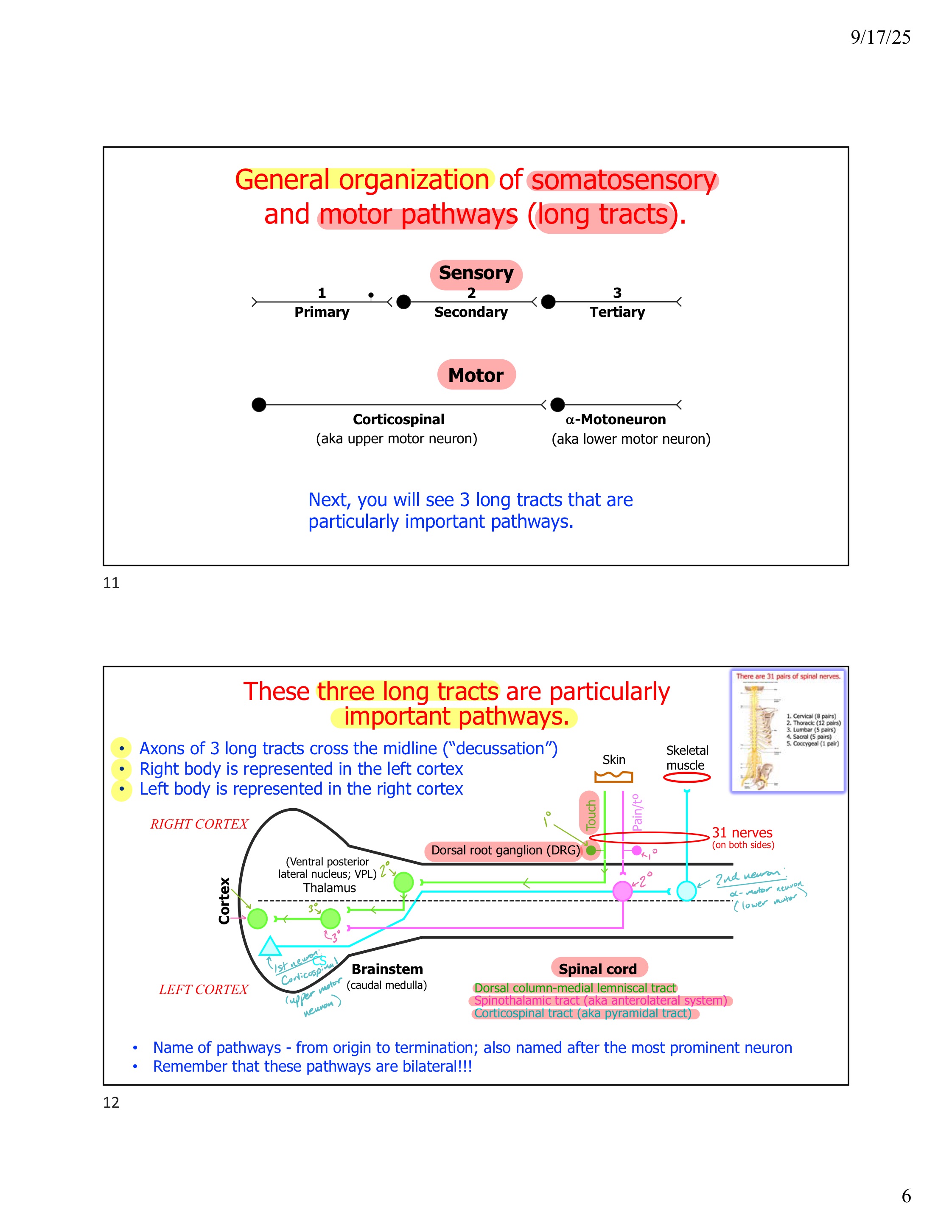
Spinothalamic tract (anterolateral system)
Sensory information is passed by this tract: Pain & Temperature.
1st order neuron: also located in dorsal root ganglion (DRG).
Axon of 1st order neuron ascends ipsilaterally in same segment as spinal cord.
2nd order neuron: dorsal horn of spinal cord (crosses midline here)
Axon of 2nd order neuron crosses midline & continues up to thalamus => contralateral.
3rd order neuron: Ventral posterior lateral (VPL) nucleus of thalamus.
Sends 3rd order neuron projections to somatosensory cortex.
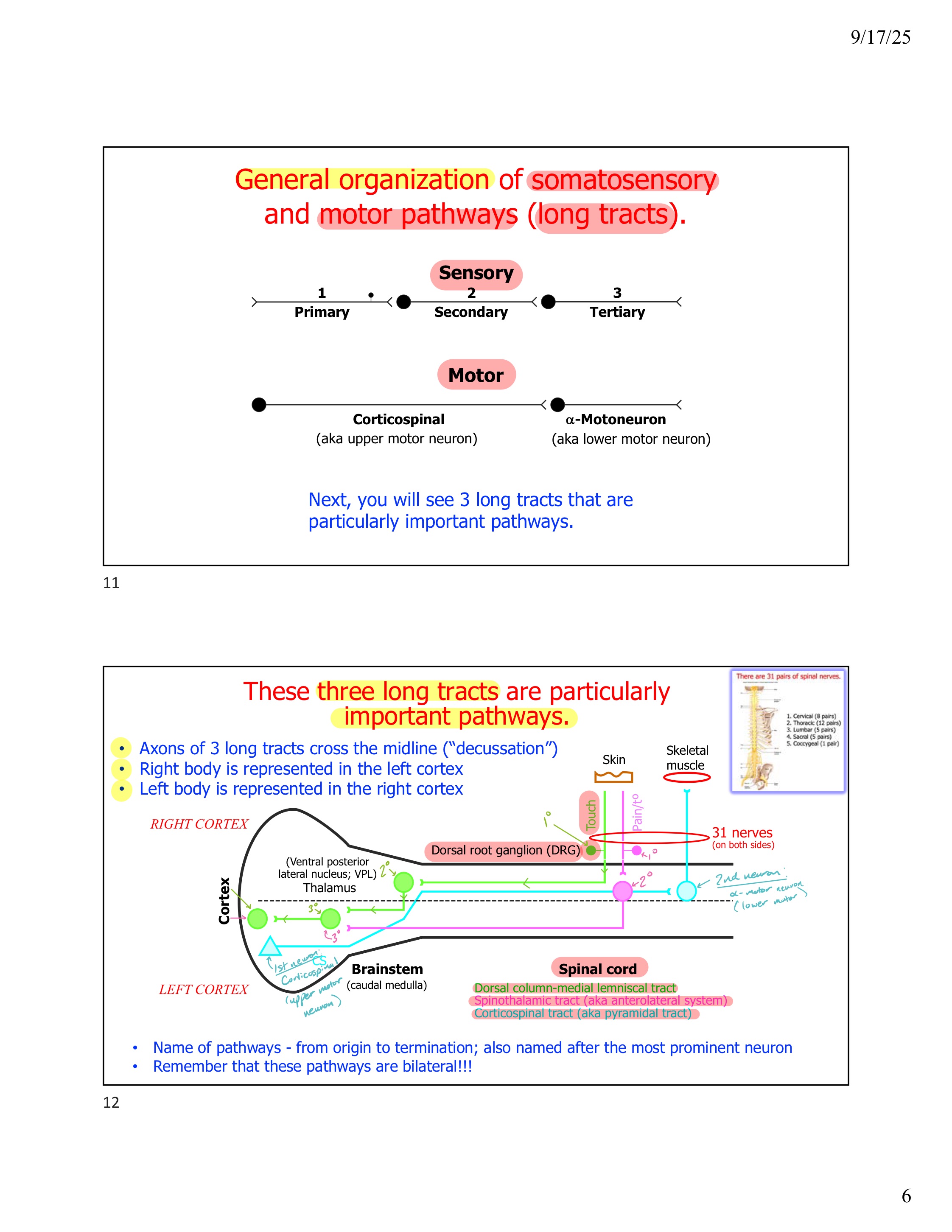
Dorsal column-medial lemniscal tract and Spinothalamic tract
Different types of information but arrives at same area of cortex.
Corticospinal tract
Begins in cortex => 1st neuron: Corticospinal (upper motor) neuron.
*Remember: only 2 neurons in motor tract.
Crosses midline in same area Dorsal column-medial lemniscal tract cross: caudal medulla.
Continues contralaterally to spinal cord => 2nd neuron: α-motor (lower motor) neuron.
Then, innervated skeletal muscle.
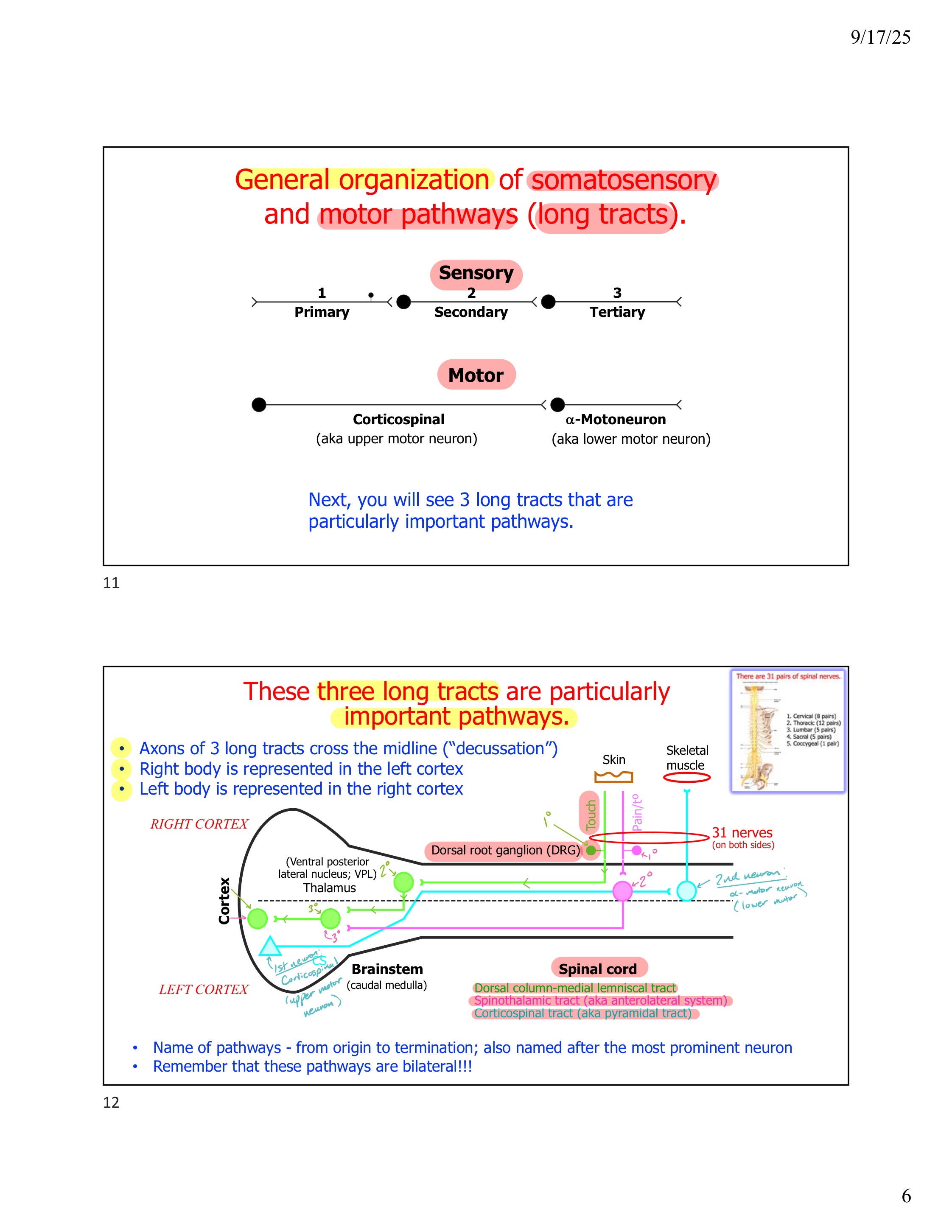
All 3 Long tracts are:
In the same spinal nerve on both sides of spinal cord
31 pairs mean:
31 nerves on each side of spinal cord = 62 nerves in the body total. Each nerve is organized with the 3 long tracts.
Sensory information of dorsal solemn-medial lemniscal tract
Touch
Sensory information of Spinothalamic tract
Pain & temperature
Corticospinal tract is a:
Motor pathway
Right body is represented:
Contralaterally in the left cortex
Left body is respresented:
Contralaterally in the right cortex
Both sensory & motor (3 long tracts) eventually:
Crosses midline
In Dorsal column-medial lemniscal tract:
There are also neurons that express different types of neurons that are not sensitive to touch. They are sensitive to pressure.
Dorsal column-medial lemniscal tract: Proprioception
Body’s ability to sense its own position, movement, and balance — sometimes called the “sixth sense.”
Along with vibrations
Ex: With closed eyes, you can tell where is your arms and legs are.
In summary, Dorsal column-medial lemniscal tract =>
Vibration, proprioception, touch
(Vid: 1:13:00)
Sensory input from the face is communicated by:
Trigeminal nerve (CN V)
The sensory information that is passed through axon of CN (V) is:
The same: pain, temperature, vibration, pressure, touch, and proprioception (like jaw position). Sensory information is sent by different axons to the CNS.
Ex: With closed eyes, you can determine the position of you jaw: if it’s closed or open.
Trigeminal system (CN V) pathway
Main sensory nucleus of the middle pons. Receives projections from large diameter neurons, which are associated with receptors which are sensitive to touch. 2nd order neurons are located in main sensory nucleus (in middle pons).
Small diameter neurons pass pain and temperature information. Located in spinal nucleus. 2nd order neurons cross midline, go up to thalamus (ventral trigeminal-thalamic pathway), then VPM (Ventroposterior medial of thalamus).
*VPL => dorsal column-medial lemniscal or Spinothalamic
*VPM => Trigeminal
3rd order nuerons: send projections to face region of somatosensory cortex.
Somatosensory cortex: there is a region which is dedicated to analysis of sensory information (touch, pain, temperature) coming from face.
Corticospinal (pyramidal) tract:
Control voluntary movements (motor)
Corticospinal (pyramidal) tract
Begins in cortex
Goes down to innervate α-motor neurons
Lumbar spinal cord: Dorsal horn:
Sensory axons & 2nd order neurons of the Spinothalamic tract
Lumbar spinal cord: Ventral horn:
α-motor neurons
Lumbar spinal cord: Intermediate region:
Preganglionic neurons of sympathetic nervous system (SNS), located between T1 and L3
Lumbar spinal cord structures
Gracile Fasciculus (DC/ML) - lower body
Lateral corticospinal tract
Spinothalamic tract
What is not located in the Lumbar Spinal Cord?
Cuneate Fasciculus (Instead, it is located up in the cervical spinal cord)
Cervical spinal cord structures
Cuneate Fasciculus (DC/ML)
Gracile Fasciculus (DC/ML) - lower body
Lateral corticospinal tract
Spinothalamic tract
Lesions produce:
Characteristic deficits AT AND BELOW the level of the lesion
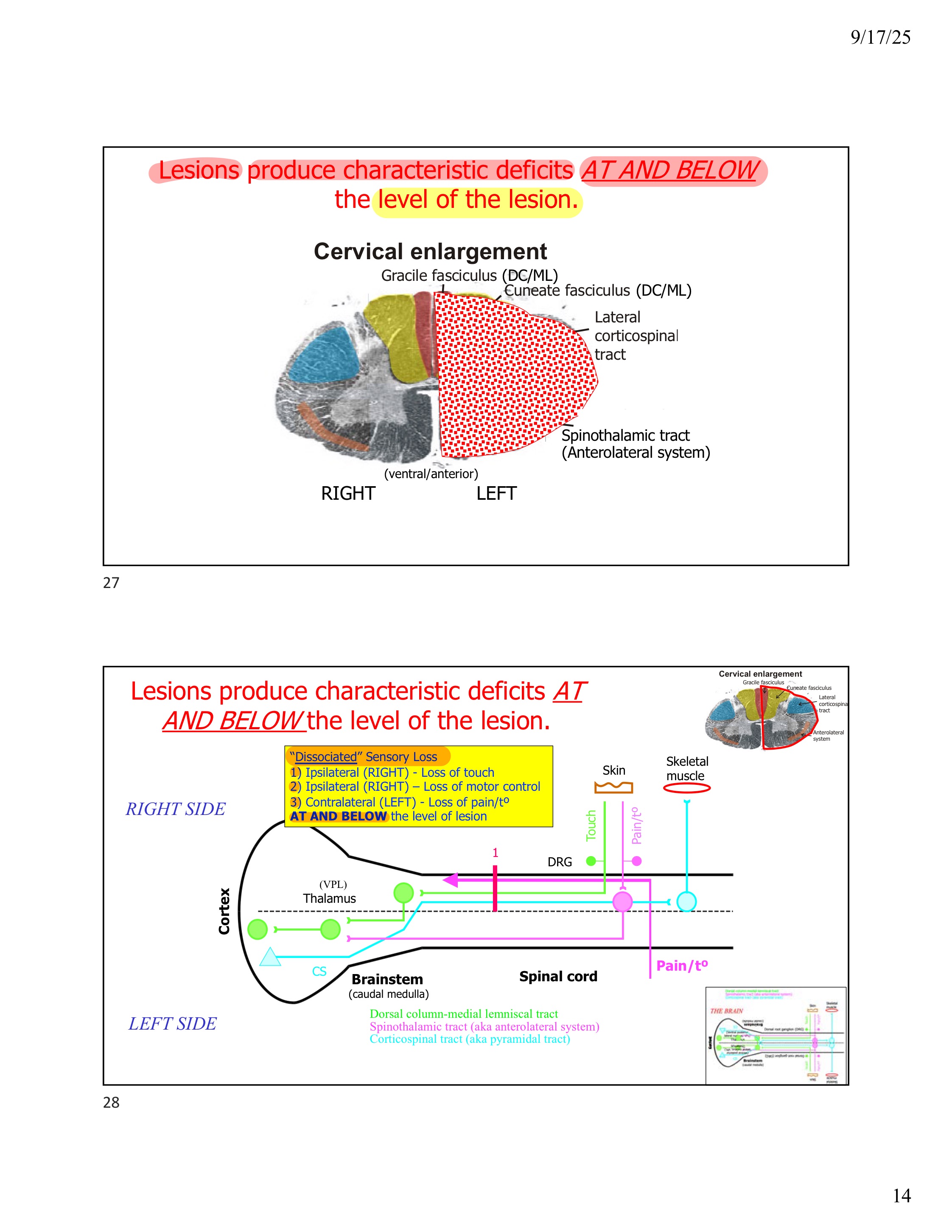
Lesion of the left hemisection: Touch
Ipsilateral => loss of touch sensation at the level of injury and below
Contralateral => NO loss of touch sensation
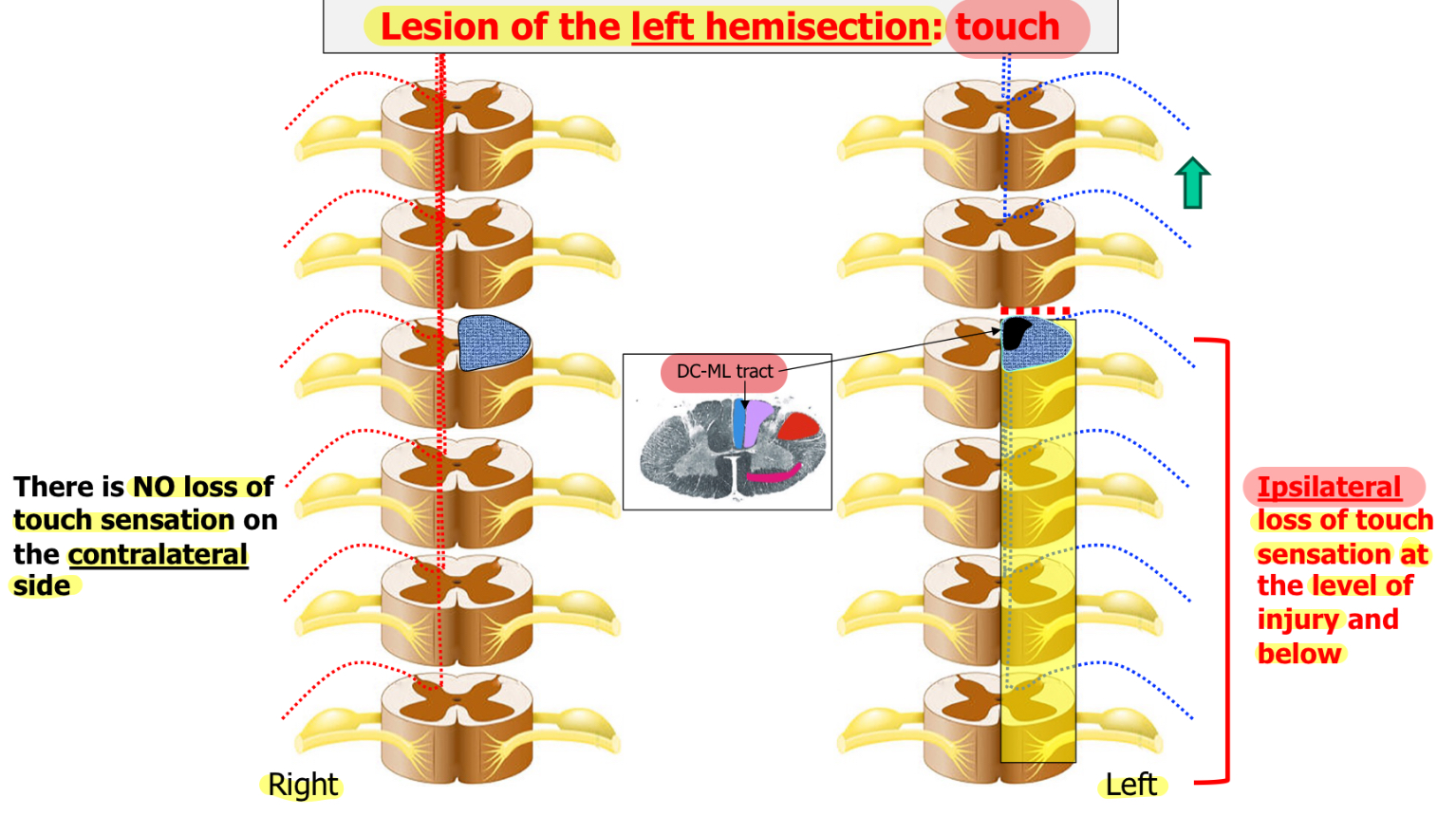
Lesion of left hemisection: Motor Control
Ipsilateral => loss of motor control at the level of lesion and below
Contralateral => NO loss of motor control
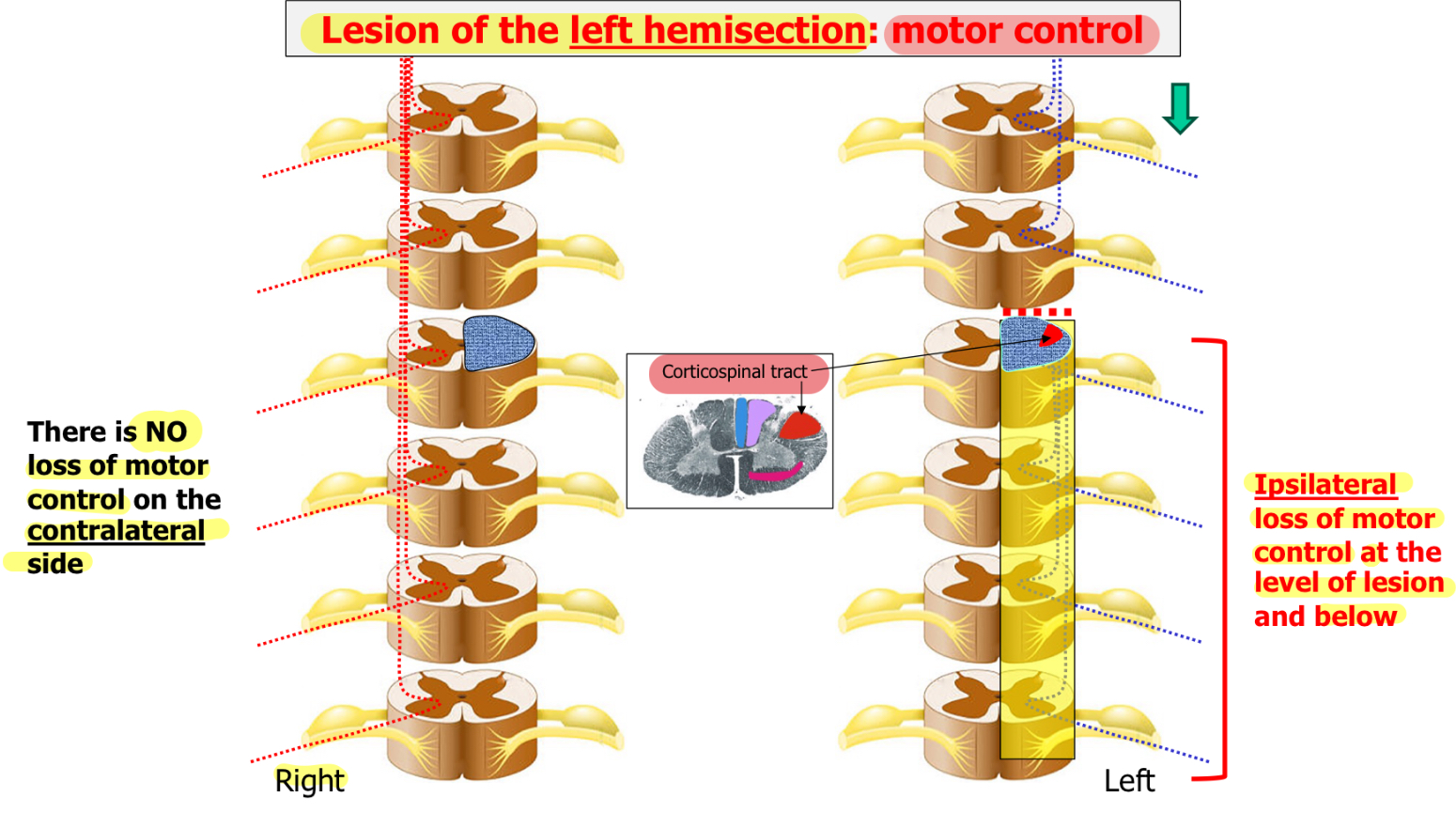
Lesion of left hemisection: Pain & Temp
Ipsilateral => Loss of pain and temperature sensation only from one spinal cord segment
Because 2nd order neurons crosses midline. Sensory information from 1 dermatome will disappear. All other signals still continue and not be interrupted.
Contralateral => Loss of pain and sensation at level of injury and below
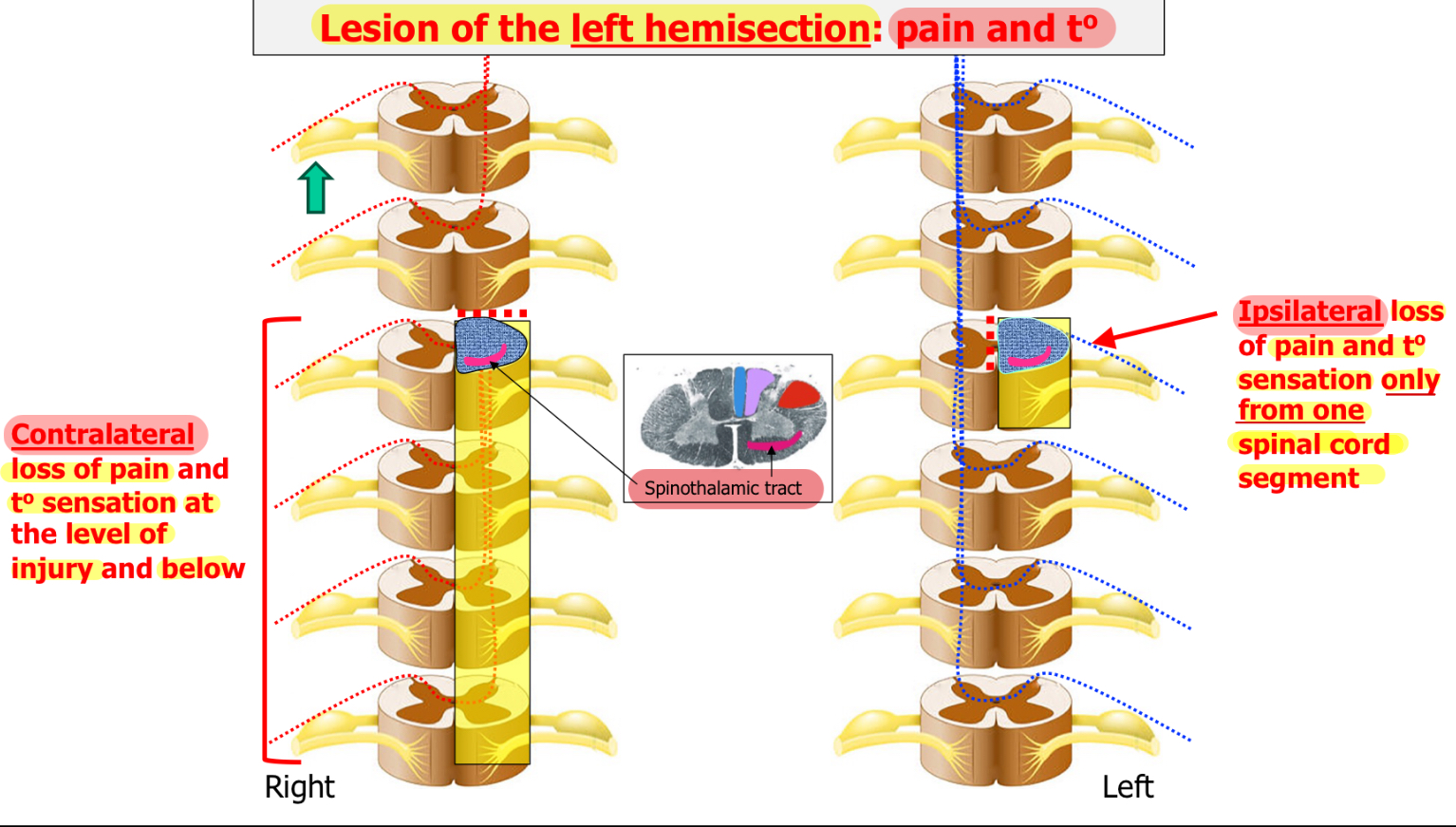
Lesion above the medulla:
Full loss of sensory information and motor control on the contralateral side
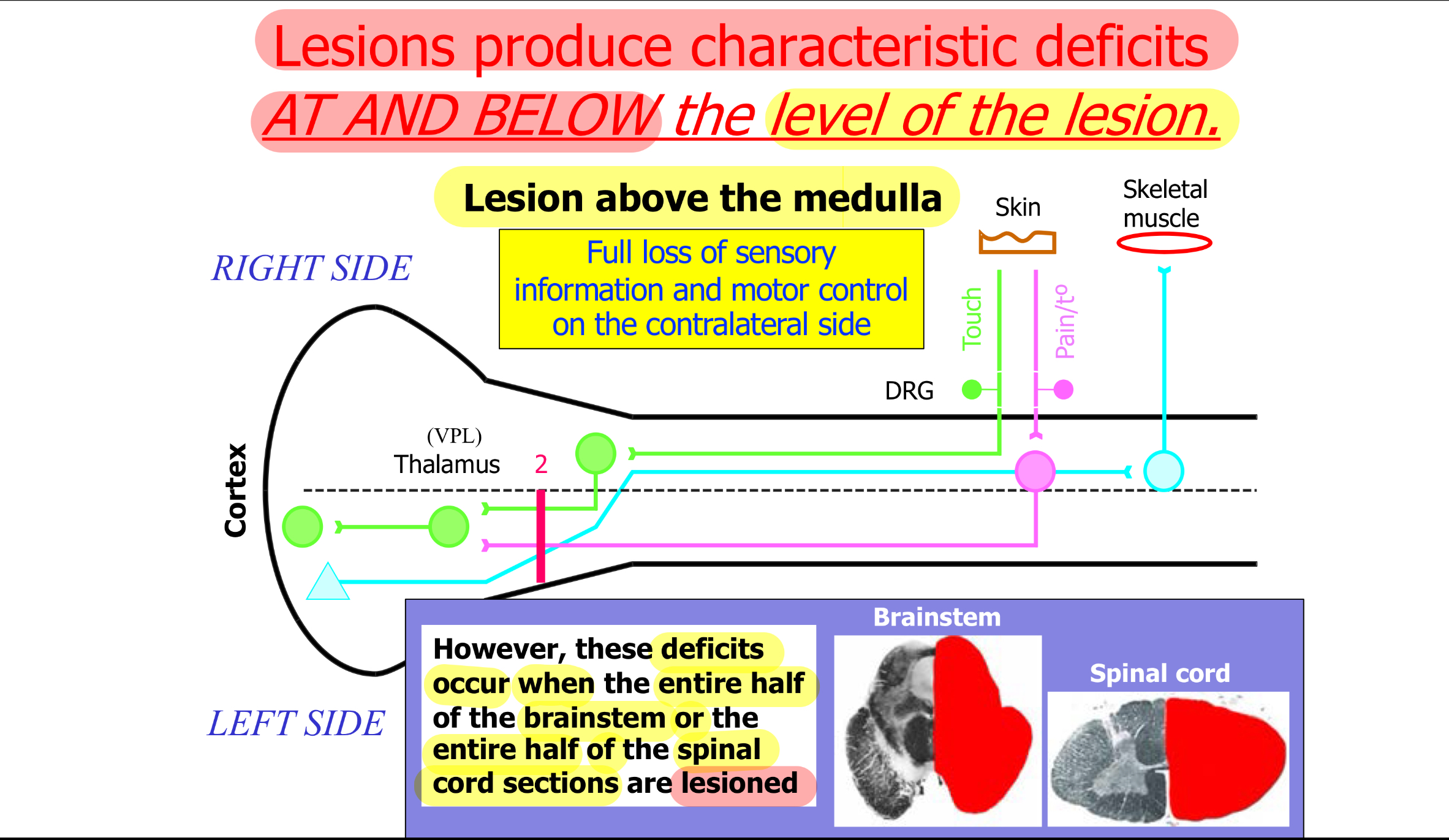
Caudal Medulla
2nd order neuron of the Dorsal Column-Medial Lemniscus (DC-ML) tract (touch information)
Level of brainstem where DC-ML crosses midline
Level where Corticospinal tract (Motor information) also across the midline
Where is decussation for the Spinothalamic tract? (Decision = crosses)
In same segment of spinal cord
Rostral Medulla
Pain and temperature information, not touch
Structures of Lumbar Spinal Cord (*ON EXAM*)
Gracile Fasciculus (DC/ML) - lower body
Lateral Corticospinal tract
Spinothalamic tract
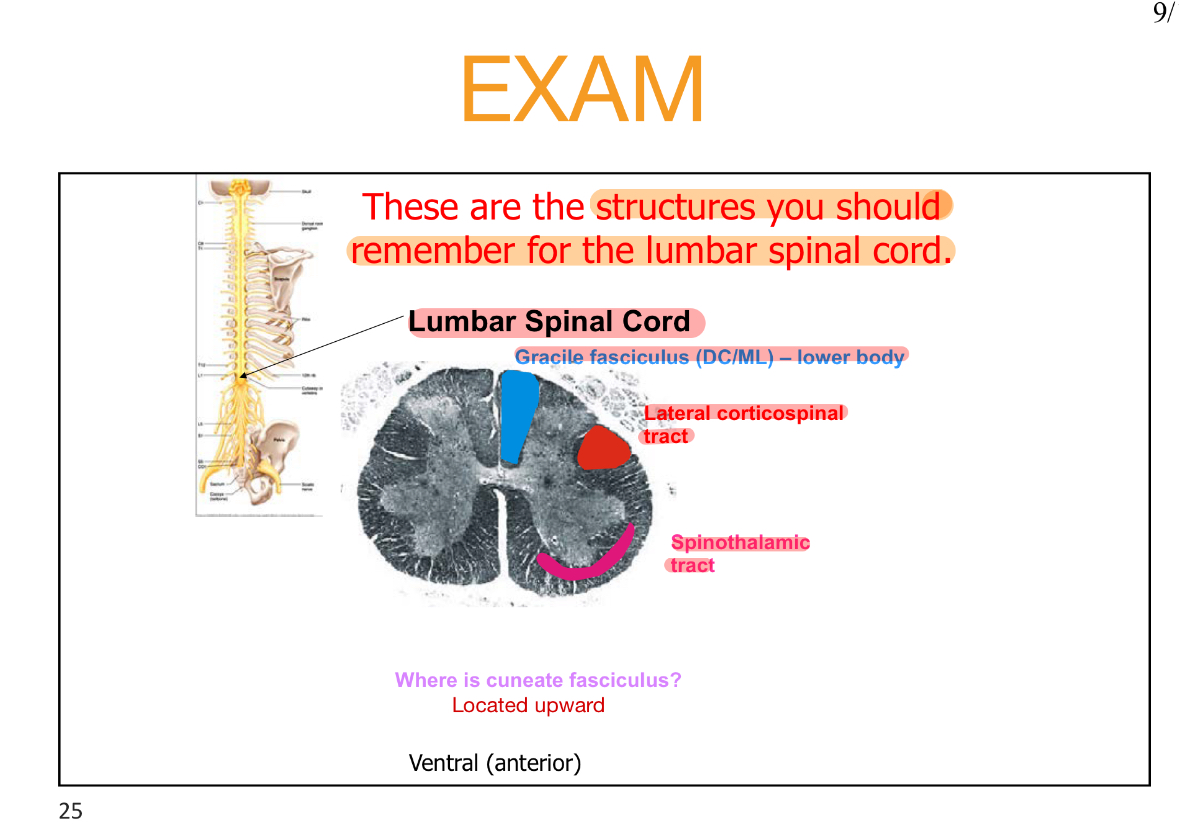
Structures of Cervical Spinal Cord (*ON EXAM*)
Gracile Fasciculus (DC/ML) - lower body
Cuneate Fasciculus (DC/ML) - upper body
Lateral Corticospinal tract
Spinothalamic tract
Structures of Middle Medulla (*ON EXAM*)
Spinal trigeminal nerve & tract (CN V)
Corticospinal tract
Medial Lemniscus
Hypoglossal nerve (CN XII)